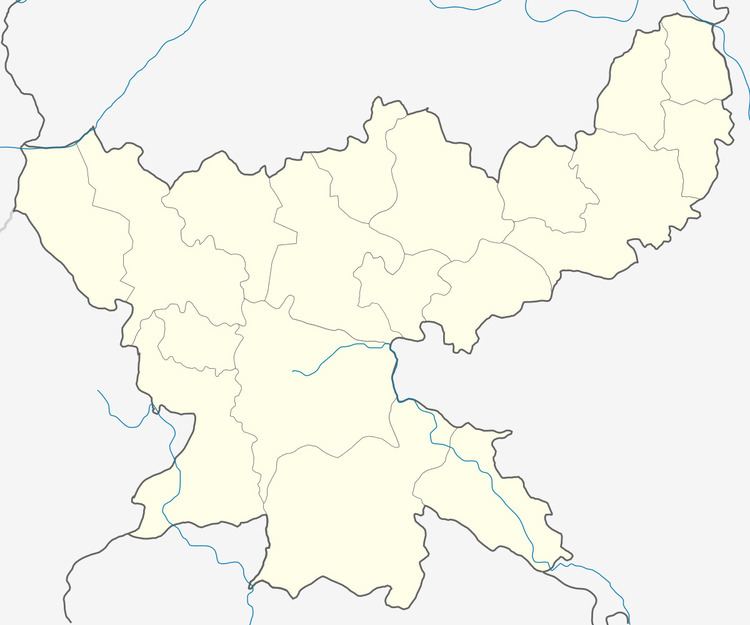 | ||
Jharia Coalfield is a large coal field located in the east of India in Jharkhand. Jharia represents the largest coal reserves in India having estimated reserves of 19.4 billion tonnes of coking coal.
Contents
Coal field
The coal field lies in the Damodar River Valley, and covers about 110 square miles (280 square km), and produces bituminous coal suitable for coke. Most of India's coal comes from Jharia. Jharia coal mines are India's most important storehouse of prime coke coal used in blast furnaces, it consists of 23 large underground and nine large open cast mines.
History
The mining activities in these coalfields started in 1894 and had really intensified in 1925. The first Indians to arrive and break monopoly of British in Coal mining were Gujarati railway contractors from Kutch some of whom decided to plunge into the coal mining business and were thus the pioneers in starting coal mining in Jharia coalfields belt around 1890–95. In Jharia-Dhanbad belt Seth Khora Ramji Chawda was the first Indian to break monopoly of Europeans and founded Khas Jharia, Golden Jharia, Fatehpur, Balihari, Khas Jeenagora, East Bagatdih Collieries with their brothers Teja Ramji Chawda, Jetha Lira Jethwa, Akhoy Ramji Chawda, Pachan Ramji Chowra between 1894 and 1910. In Pure Jharia Colliery Khora Ramji and brothers were partners with Diwan Bahadur D.D. Thacker. The Encyclopaedia of Bengal, Bihar & Orissa (1920) by British Gazetteer mentions about Seth Khora Ramji as under :-
..at that time (in 1890s) the Jharia coal fields were being exploited by Europeans and Seth Khora Ramji was first Indian to seize the opportunity. He purchased two collieries to begin with. Gradually others from Kutch and Gujarat followed suit and now Jharia has been changed into a Gujarati settlement with about 50 Kutchi out of 92 Gujarati collieries proprietors with Seth Khora Ramji as head of them all. He is now sole proprietor of two collieries and a financing member of about eight collieries. Several district officials have remarked him as multi-millionaire, one of the first class parties in Jharia.
The life sketch of Govamal Jivan Chauhan is also another miner mentioned by the British in gazetter who founded collieries at Teesra, Budroochuck and Pandeberra around 1908–10, Jagmal Raja Chauhan owned Rajapore colliery with Manji Jeram of Madhapar, while Khimji Walji owned Tisra mines and Khimjee & Gangjee Dossa owned mines at Kujama, Fettehpur, North Kujama, North Akashkinari, Katrasgaarh, Central Jharia, Indian Jharia and Lower Upper Jharia, Khengar Trikoo of Anjar at Khas Joyrampur There were more than 50 mines owner from Mistri community of Kutch, who took on lease the coal mining fields from Raja of Jharia at various locations to start collieries at Khas Jharia, Jamadoba, Balihari, Tisra, Katrasgarh, Kailudih, Kusunda, Govindpur, Sijua, Sijhua, Loyabad, Joyrampur, Bhaga, Matadih, Mohuda, Dhansar, Bhuli, Bermo, Mugma, Chasnala-Bokaro, Bugatdih, Putki, Pandibri, Rajapur, Jeenagora, Gareria, Chirkunda, Bhowrah, Sinidih, Kendwadih, Dumka, etc. The others of pre – World War I years were Khannas, Agarwallas, Kesabji Pitamber, Haithibhai Patel, Chaturbhai Sangjibhai, Kalyanji Mavji, Roys, Banerjees and Singhs.
After World War I was over other communities from Kutch, Gujarat, Marwar and Bengal followed notable among them were Amritlal Morarjee, Kriparshankar Worah, Jatashankar Dossa Chanchani, Amritalal Ojha, Lala Karamchand Thapar, Kalyanji Mavji, T.K. Khanna, Ramjush Agarwalla, J.K. Agarwalla, Kesabji Pitamber, Haithibhai Patel, Chaturbhai Sangjibhai who made their name in Jharia coalfield post World-War-I. Amritlal Ojha & Karamchand Thapar later went on to become President of International Chamber of Commerce. After World War II and independence of India, Jharia coal mines owner prospered beyond imagination but in 1971 the coal mines were nationalized by Indira Gandhi by an act of parliament. A major chunk of these coal bearing region including Raniganj and Paraskole was with the Jharia miners like Chanchani & Worah, Poddars, Agarwallas, Mistris of Kutch, etc.
Rai Bahadur D D Thacker started a Labour's School in Jharia to train labors for coalmines. While the Gujrati Primary School at Jharia for children was started by Mestri Colliery owners, who felt the need of a Primary School at Jharia. Although, after nationalization of the coal mines in 1971–73 all of them lost their mines and assets and a downturn in fortune of coal mining community came.
Coal field fire
Jharia is famous for a coal field fire that has burned underground for nearly a century. The first fire was detected in 1916. According to records, it was the Khas Jharia mines of Seth Khora Ramji Chawda (1860–1923), who was a pioneer of Indian coalmines, whose mines were one of the firsts to collapse in underground fire in 1930. Two of his collieries, Khas Jharia & Golden Jharia, which worked on maximum 260-foot-deep shafts, collapsed due to now infamous underground fires, in which their house & bungalow also collapsed on 8 November 1930, causing 18 feet subsidence and widespread destruction. The fire never stopped despite sincere efforts by mines department and railway authorities and in 1933 flaming crevasses lead to exodus of many residents. The 1934 Nepal–Bihar earthquake led to further spread of fire and by 1938 the authorities had declared that there is raging fire beneath the town with 42 collieries out of 133 on fire.
In 1972, more than 70 mine fires were reported in this region. As of 2007, more than 400,000 people who reside in Jharia are living on land in danger of subsidence due to the fires, and according to Satya Pratap Singh, "Jharia township is on the brink of an ecological and human disaster". The government has been criticized for a perceived lackadaisical attitude towards the safety of the people of Jharia. Heavy fumes emitted by the fires lead to severe health problems such as breathing disorders and skin diseases among the local population.
